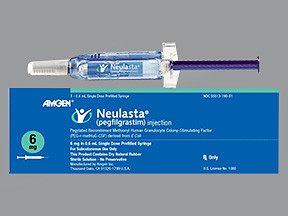PEGFILGRASTIM - INJECTION
PHONETIC PRONUNCIATION: (PEG-fil-GRA-stim)
COMMON BRAND NAME(S): Neulasta
GENERIC NAME(S): pegfilgrastim
Uses
USES: Pegfilgrastim is a man-made version of a certain natural substance made in your body. It is used to help your body make more white blood cells. White blood cells are important to help you fight off infections. Pegfilgrastim is given to people whose ability to make white blood cells is reduced (for instance, due to chemotherapy or exposure to large amounts of radiation).
How to use PEGFILGRASTIM - INJECTION
HOW TO USE: Read the Patient Information Leaflet if available from your pharmacist before you start using pegfilgrastim and each time you get a refill. If you have any questions, ask your doctor or pharmacist. This medication is given by injection under the skin as directed by your doctor. For use during chemotherapy, it is usually given once during each chemotherapy cycle. However, it should not be given within 14 days before or 1 day after chemotherapy. Ask your doctor for specific directions about when to use this medication. For use after radiation exposure, pegfilgrastim is usually given for 2 doses, one week apart. For children, the dosage may be based on their weight. If you are using this medication at home, learn all preparation and usage instructions from your health care professional and the product package. Take the medication out of the refrigerator at least 30 minutes before you inject it to allow it to reach room temperature. Do not shake the medication. Before using, check this product visually for particles or discoloration. If either is present, do not use the liquid. First clean the injection site with rubbing alcohol. Change the injection site each time to lessen injury under the skin. Do not inject pegfilgrastim into skin that is bruised, tender, red, hard, or that has scars or stretch marks. Learn how to store and discard medical supplies safely.
Side Effects
Precautions
Interactions
Overdose
Images
Reviews
Faq for PEGFILGRASTIM - INJECTION
Pegfilgrastim is an injection medication that belongs to a class of drugs known as colony-stimulating factors. It is used to stimulate the production of white blood cells in the body, which helps prevent infections in patients undergoing cancer treatments.
Pegfilgrastim is given as a subcutaneous injection, usually once per chemotherapy cycle. The injection is typically given in the fatty tissue just under the skin.
The most common side effects of Pegfilgrastim include bone pain, headache, fatigue, muscle pain, and injection site reactions such as redness, swelling, or pain. Some patients may also experience fever, nausea, or vomiting.
Pegfilgrastim usually starts working within 24 to 72 hours after administration. It helps to increase the production of white blood cells, reducing the risk of infection in cancer patients undergoing chemotherapy.
No, Pegfilgrastim should not be self-administered at home. It should be administered by a healthcare professional who is trained in giving injections.
Pegfilgrastim should be used with caution in patients with a history of allergic reactions, as it may cause severe allergic reactions in some individuals. It is important to inform your healthcare provider about any allergies or previous reactions to medications.
Pegfilgrastim is generally covered by insurance for cancer patients undergoing chemotherapy. However, coverage may vary depending on the specific insurance plan. It is advisable to check with your insurance provider to determine the extent of coverage.
Pegfilgrastim should be stored in the refrigerator between 36°F and 46°F (2°C and 8°C). The medication should not be frozen. If traveling, it can be kept at room temperature for a maximum of 48 hours, but should not exceed 77°F (25°C).
Pegfilgrastim is approved for use in adults and children aged 1 month and older. However, the exact dosing and administration instructions may vary depending on the age and weight of the child. It is important to follow the guidance of a healthcare professional.
Disclaimer
IMPORTANT: HOW TO USE THIS INFORMATION: This is a summary and does NOT have all possible information about this product. This information does not assure that this product is safe, effective, or appropriate for you. This information is not individual medical advice and does not substitute for the advice of your health care professional. Always ask your health care professional for complete information about this product and your specific health needs.

No Reviews Yet